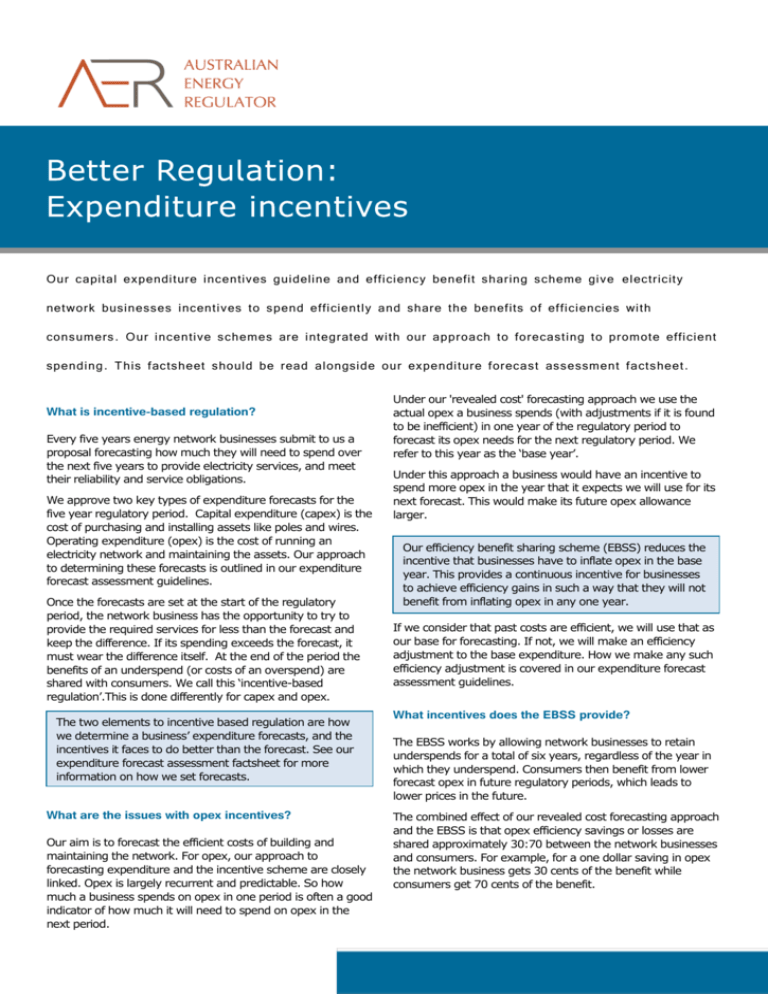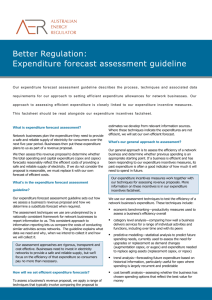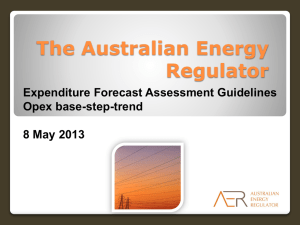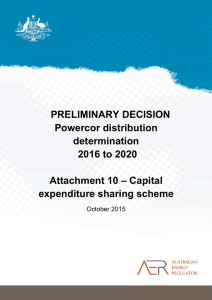DOCX
advertisement

Our capital expenditure incentives guideline and efficiency benefit sharing scheme give electricity network businesses incentives to spend efficiently and share the benefits of efficiencies with consumers. Our incentive schemes are integrated with our approach to forecasting to promote efficient spending. This factsheet should be read alongside our expenditure forecast assessment factsheet. What is incentive-based regulation? Every five years energy network businesses submit to us a proposal forecasting how much they will need to spend over the next five years to provide electricity services, and meet their reliability and service obligations. We approve two key types of expenditure forecasts for the five year regulatory period. Capital expenditure (capex) is the cost of purchasing and installing assets like poles and wires. Operating expenditure (opex) is the cost of running an electricity network and maintaining the assets. Our approach to determining these forecasts is outlined in our expenditure forecast assessment guidelines. Once the forecasts are set at the start of the regulatory period, the network business has the opportunity to try to provide the required services for less than the forecast and keep the difference. If its spending exceeds the forecast, it must wear the difference itself. At the end of the period the benefits of an underspend (or costs of an overspend) are shared with consumers. We call this ‘incentive-based regulation’.This is done differently for capex and opex. The two elements to incentive based regulation are how we determine a business’ expenditure forecasts, and the incentives it faces to do better than the forecast. See our expenditure forecast assessment factsheet for more information on how we set forecasts. What are the issues with opex incentives? Our aim is to forecast the efficient costs of building and maintaining the network. For opex, our approach to forecasting expenditure and the incentive scheme are closely linked. Opex is largely recurrent and predictable. So how much a business spends on opex in one period is often a good indicator of how much it will need to spend on opex in the next period. Under our 'revealed cost' forecasting approach we use the actual opex a business spends (with adjustments if it is found to be inefficient) in one year of the regulatory period to forecast its opex needs for the next regulatory period. We refer to this year as the ‘base year’. Under this approach a business would have an incentive to spend more opex in the year that it expects we will use for its next forecast. This would make its future opex allowance larger. Our efficiency benefit sharing scheme (EBSS) reduces the incentive that businesses have to inflate opex in the base year. This provides a continuous incentive for businesses to achieve efficiency gains in such a way that they will not benefit from inflating opex in any one year. If we consider that past costs are efficient, we will use that as our base for forecasting. If not, we will make an efficiency adjustment to the base expenditure. How we make any such efficiency adjustment is covered in our expenditure forecast assessment guidelines. What incentives does the EBSS provide? The EBSS works by allowing network businesses to retain underspends for a total of six years, regardless of the year in which they underspend. Consumers then benefit from lower forecast opex in future regulatory periods, which leads to lower prices in the future. The combined effect of our revealed cost forecasting approach and the EBSS is that opex efficiency savings or losses are shared approximately 30:70 between the network businesses and consumers. For example, for a one dollar saving in opex the network business gets 30 cents of the benefit while consumers get 70 cents of the benefit. What are the issues with capex incentives? For capex, the sharing of underspends and overspends happens at the end of each regulatory period. This is when we How the the network expenditure measures fit together update business’ regulatory asset base (RAB) to include new capex it invested in during the period. A business’ RAB is made up of its capex investments, which it is allowed to earn a return on. retain 70 per cent of the underspend or overspend. This means that for a one dollar saving in capex a business gets 30 cents of the benefit while consumers get 70 cents of the benefit. In addition, if a business’ capex exceeds the forecast, we will examine their spending. If we determine all or some of the overspending was inefficient, the business may not be allowed Expenditure incentives to add the excess spending to its RAB. This means consumers will not fund that expenditure. This is referred to as an ex-post Efficiency benefit sharing scheme review. Capital expenditure incentive guideline Expenditure forecast assessment guideline Service target performance incentive scheme Upfront incentives (ex ante measures) Examining past spending (ex post measures) General incentive based regulation Statement on the efficiency of actual capital expenditure Capital expenditure sharing scheme (CESS) Ex post exclusions from the regulatory asset base for Use of actual or forecast depreciation to roll forward the regulatory asset base If a business spent less than its approved forecast, it will benefit during the period. Consumers benefit at the end of the period when the RAB is updated to include less capex compared to if the business had spent the full amount of the capex forecast. This leads to lower prices in the future. As the end of the regulatory period approaches, the time available for the business to retain any savings gets shorter. So the earlier a business incurs an underspend in the regulatory period, the greater its reward will be. As a result, the incentive for a business to spend less than its capex forecast declines throughout the period. So the business may choose to spend capex later, or on capex when it may otherwise have spent on opex, even if it may not be efficient to do so. Also, in the past, we were required to add all capex to a business' RAB regardless of whether it was efficient, or exceeded the approved forecast. This meant consumers were paying prices that reflected all a business’ capex which may have included inefficient capex. What capex incentives are in the guideline? The capital expenditure sharing scheme (CESS) provides a network business with the same reward for an efficiency saving and same penalty for an efficiency loss regardless of which year they make the saving or loss in. When the CESS is implemented, a business will retain 30 per cent of an underspend or overspend, while consumers will inefficient capital overspends, inflated related party margins, capitalised operating expenditure Our capex incentive measures mean that consumers pay only a portion of efficient overspends, pay nothing for inefficienct overspends and consumers share in the benefits when a network business is able to spend less than its forecast capex allowance. How do our incentive measures work as an overall package? Our incentive schemes encourage network businesses to make efficient decisions. They give network businesses an incentive to pursue efficiency improvements in opex and capex, and to share them with consumers. Incentives for opex and capex are balanced (30 per cent) and constant. They are also balanced with the incentives under our service target performance incentive scheme (STPIS). This encourages businesses to make efficient decisions on when and what type of expenditure to incur, in order to meet service reliability targets. The ex post review complements the CESS to provide network businesses with an additional incentive to help ensure that any overspends are efficient and prudent. Under the CESS a business bears 30 per cent of the overspend. However, if the overspend is found to be inefficient, ex post reviews mean the business will bear 100 per cent of the inefficient overspend. More information The capex incentives guideline and EBSS are available on our website at www.aer.gov.au/node/18869. This guideline and scheme form part of the Better Regulation program. We initiated this program following changes to the regulatory framework in late 2012. The program includes seven new guidelines that outline our revised approach to determining electricity network revenues and prices, and our establishment of the Consumer Challenge Panel. For more information on the Better Regulation program please visit our website www.aer.gov.au/better-regulation-reform-program.








